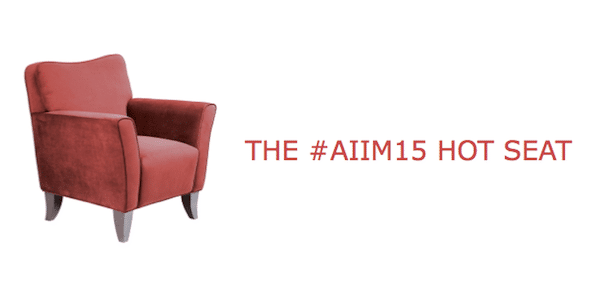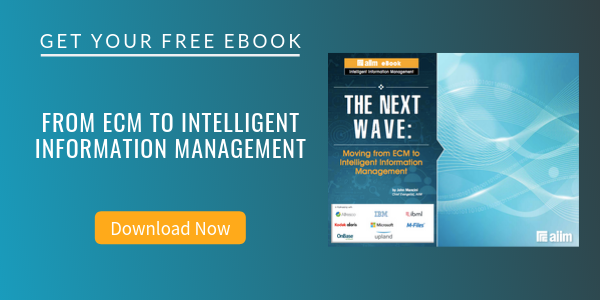
The #AIIM15 Digital Transformation Hot Seat: 2015 – the Year CIO Means “Career Isn’t Over”
Enterprise Content Management (ECM) | Intelligent Information Management (IIM) | Digital Transformation
As we start to think about #AIIM15, I thought I would ask a number of our sponsors a few identical questions in order to get an understanding of how they see the future of our industry -- and let those of you attending start to think about your own questions to ask them in San Diego. Here are the three questions I'll ask:
- What are the three biggest challenges you see your customers facing while trying to “Embrace the Chaos”?
- What do you see as the three most important trends related to Information Management facing organizations over the next 18-24 months? What will be different in our industry two years from now?
- What are the three most important things attendees should know about your company?

Phil Robinson, Senior Vice President of Business Development at Zia Consulting, says CIO does NOT stand for "Career is Over".
What are the three biggest challenges you see your customers facing while trying to “Embrace the Chaos”?
The three biggest challenges we’ve seen our customers face here at Zia are 1.) Garnering ECM user adoption (vs. “ECM avoidance”), 2.) Addressing the compliance and security needs of the organization versus the wants of users, and 3.) Avoiding the notion that CIO means “Career is Over.”
ECM Avoidance and IT vs. Users: The legacy of ECM systems is one of complexity, with challenging user interfaces, multiple logins, and more—which is why for most organizations, email applications and shared drives are still the dominant form of “content management.” It’s also why many ECM technologies are best known as “shelfware.” We believe that when you offer solutions that “work the way you do, using the tools you use today,” users aren’t forced to embrace alternatives that don’t fit Enterprise IT strategy. Solutions that leverage tools like Office, Email, and SharePoint Integration and Cloud Sync deliver content management systems that work—providing the ease of use and familiarity users want, with the security and compliance companies need.
CIO = Career Isn’t Over. If CIOs can solve the ECM avoidance issue—maintaining employee usage of tools they prefer to use like email and SharePoint—while addressing security concerns around tools like Dropbox and solving Governance with simplified Records Management processes, they will have taken a major step in ensuring they still have a job in 2016. Once that’s done, the CIO can take the next step towards the boardroom by delivering technology as a competitive advantage, truly impacting the strategic direction of the enterprise. Thus, the title of CIO can actually mean “Career Isn’t Over.”
What do you see as the three most important trends related to Information Management facing organizations over the next 18-24 months? What will be different in our industry two years from now?
We believe the three most important trends related to Information Management over the next 18 – 24 months are 1.) Solving SharePoint, 2.) Solving document security, and 3.) Solving information governance/records management issues.
Solving SharePoint: Across both the public and private sectors, companies have made an investment in SharePoint, and it is clear that it isn’t going to simply disappear from their daily operations. Instead of looking to replace SharePoint, executives often want to implement control and compliance around it—essentially implementing a co-existence strategy. Through our partnership with SeeUnity, we’ll often integrate existing SharePoint instances with a more powerful content hub on the backend, such as Alfresco, so that users can continue to collaborate in the way they are accustomed to while still addressing the company’s true document and records management needs.
Solving Document Security: Often, what keeps a CIO up at night are concerns about appearing on the front page of the newspaper due to a leak of corporate data/documents. Fortunately, there are secure collaboration solutions available that address this issue for both internal documents as well as those going outside the organization. Through a strategic partnership with Covertix, Zia’s Universal Document Security (UDS) solutions deliver secure collaboration, whether it's via email, Alfresco Cloud, or even consumer sharing technologies such as Dropbox or Box.net. These solutions enable internal and external parties to share confidential files with monitoring, auditing, and control--significantly reducing overall risk.
Solving Information Governance/Records Management: The legacy of Records Management systems is one where RM solutions have traditionally been designed for dedicated compliance offers, rather than content creators, and deployed in a standalone environment, disconnected from collaboration and ECM systems. This duplication of effort, moving documents from ECM to RM systems and back again, adds tremendous cost and complexity to the information governance effort within the Enterprise, and makes it challenging for users to find and use records when they need them. To combat this issue, we provide Easy Records Management (Easy RM) Solutions, where “everyone’s a records manager, and nobody knows it” - connecting those who are creating content with the compliance process. Easy RM incorporates the tools you use on a daily basis, reducing barriers to implementation and adoption.
What are the three most important things attendees should know about your company?
The three most important things to know about our company in 2015 are 1.) If you are a CIO, we can help save your career, 2.) We are content people who solve your business needs surrounding the management of your business-critical content, and 3.) We work with you.
CIO = Career Isn’t Over: Traditionally, the primary role of the CIO is to secure and govern information while also make technology investments that provide cost savings for the company. The CIO is known for putting their focus on reducing costs instead of adding new value and has been criticized widely since 2008 as having little knowledge of what it actually means to be a CEO or sit on a board. However, Zia would like to offer 5 reasons you still need a CIO (and how we can help save their career): 1.) To solve ECM avoidance once for all, 2.) To solve SharePoint, 3.) To solve the DropBox problem, 4.) To solve Information Governance, and 5.) Once 1-4 are completed, deliver true business value with technology as a competitive advantage.
Content People: Zia understands the importance of content to your success–with a focus on where your content comes from and, more importantly, where you need it to be. We recognize that these requirements may be unique to your industry, which is why we have established Zia Public Sector Solutions, Zia Solutions for Financial Services, and other vertical-focused practice groups. Additionally, we appreciate that content workflows differ by division or department, which is why we’ve developed solutions for Corporate Finance, Corporate Legal, Human Resources, and other branches of your organization. To address the critical role that content plays in the strategic direction of your organization, Zia’s “Content Consultancy” Services deliver an end-to-end assessment of your existing content processes and a roadmap for how document automation and other enhancements can provide a measurable impact on your organization’s success.
Working with You: At Zia, we are committed to providing measurable business results on time and within budget. We deliver solutions powered by industry-leading partners like Alfresco for ECM and Ephesoft for Intelligent Document Capture to give us the benefits of an open platform and the most modern technology in the content world. As a guiding principle, we will always work with you, in a true partnership, to provide a solution that is yours to own and manage in the future.
About John Mancini
John Mancini is the President of Content Results, LLC and the Past President of AIIM. He is a well-known author, speaker, and advisor on information management, digital transformation and intelligent automation. John is a frequent keynote speaker and author of more than 30 eBooks on a variety of topics. He can be found on Twitter, LinkedIn and Facebook as jmancini77. Recent keynote topics include: The Stairway to Digital Transformation Navigating Disruptive Waters — 4 Things You Need to Know to Build Your Digital Transformation Strategy Getting Ahead of the Digital Transformation Curve Viewing Information Management Through a New Lens Digital Disruption: 6 Strategies to Avoid Being “Blockbustered” Specialties: Keynote speaker and writer on AI, RPA, intelligent Information Management, Intelligent Automation and Digital Transformation. Consensus-building with Boards to create strategic focus, action, and accountability. Extensive public speaking and public relations work Conversant and experienced in major technology issues and trends. Expert on inbound and content marketing, particularly in an association environment and on the Hubspot platform. John is a Phi Beta Kappa graduate of the College of William and Mary, and holds an M.A. in Public Policy from the Woodrow Wilson School at Princeton University.



